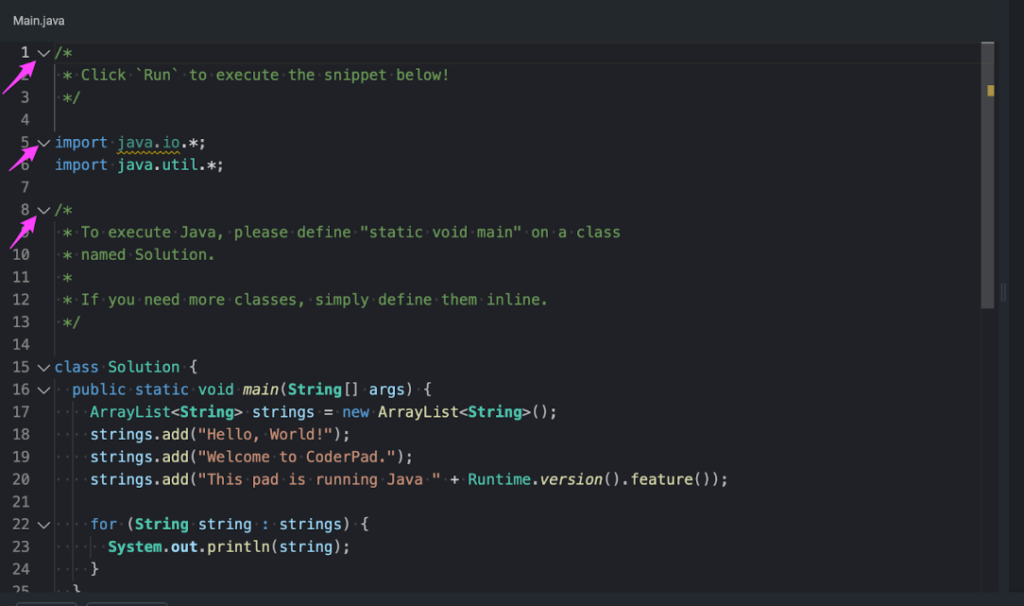Code editor
Last updated on • Disponible en Français
The Interview platform provides a feature-rich code editing environment for your candidate to work in.
We support over 30 programming languages and have different libraries and frameworks built in per language, and our core editor functionality is available for each programming language (unless otherwise specified).
We also provide enhanced support with better autocomplete and other editor functionality for the following languages:
- Ruby
- Python 3
- JavaScript
- Java
- C
- C++
- C Sharp
- Swift
- Kotlin
- TypeScript
Code editor features:
✅ To run or execute your code at anytime, simply click on the Run button in the top left corner or use the keyboard short cut: ⌘ + enter OR ⌘ + S for iOS or CTRL + enter OR CTRL + S for Windows.
Autocomplete
To use autocomplete, just start typing and the editor will make suggestions:
Scroll through the suggestions using the up and down arrows to find the code you’re looking for. Then, hit Tab or Enter to accept the suggestion and have Interview fill in the code.
By default, autocomplete is triggered whenever . is pressed. You can also use Ctrl + Space to initiate the autocomplete at any point.
Auto-close Brackets
Interview provides the ability to automatically close related symbols — like parenthesis, brackets, and quotation marks.
✅ To help reduce potential bugs, this feature is enabled by default.
The full list of symbols that will auto-close are:
[]– Brackets{}– Curly braces()– Parenthesis""– Double quotation marks''– Single quotation marks
Multi-Cursor
Multi-cursor functionality lets you edit multiple lines at once. This can be especially useful when you want to make the same change to multiple lines of code.
Select cursor positions, lines, and sections
Multi-cursor has a number of different methods for line selection:
Alt+Clickselects or deselects one or more cursor positions, anywhere in the code.Alt+Shift+Clickand drag selects multiple contiguous lines at a time.
This method of multi-line select stacks on top of other methods, since you only have to hold down the modifier key when actively clicking the mouse to select a new line.
Because of this, you can even scroll in the middle of selecting lines.
If you’ve selected adjacent lines, but later realize you missed a line you wanted to add, you can use this method to add to your list of selected lines.
Alt + Ctrl + Up/Down in Windows or Option + Shift + Up/Down in Mac allows you to select contiguous lines above and below your current selection.
Duplicate lines
Alt + Shift + Up/Down duplicates the lines you are on.
Code folding
Free-up space and improve readability by temporarily hiding code using code folding.
Hover over the space between the line numbers and the code. You will see dropdown arrows appear at the beginning of all major code blocks such as comments, imports, classes, methods, etc.
Click on an arrow to close the code block; click on it again to open it back up.
Error highlighting
Similar to other IDEs, Interview highlights errors as you make them by underlining them in red. Yellow lines signal warnings.
Hover over the red lines to see more information about the error.
Right-click options
Right-click opens a dialog box with common tools, code navigation options, and access to the Command Palette.
If you are using one of the enhanced support languages, you see a list of options related to navigating around the code if the cursor is on a class, object, method, or function:
If you are using a non-enhanced support language, there are no navigation options:
Command Palette
Right-Click and select Command Palette, or press F1 on your keyboard.
The Command Palette provides access to many pad commands and their related keyboard shortcuts.
Run code snippets
There may be instances where you don’t want to run all the code in the editor, but rather just a single function or method.
You can do this by highlighting the code you want to run, and then either clicking the Run button at the top of the editor or using the ⌘ + enter OR ⌘ + S (Mac) / CTRL + enter OR CTRL + S (Windows) shortcuts:
Frontend & backend multi-file layout
Interview provides an interface specifically for frontend and backend coding. You can find more information on using the this interface on the languages page here.
For more information on creating multi-file frontend questions, check out this guide.






